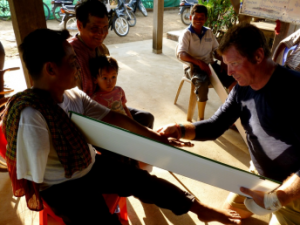Rhyka Tiangco turns two today but there won’t be a big birthday party for this girl from the Philippines. Her parents, Rhyan and Kathrina Jane, need all the money they can get for a cochlear implant for their daughter. Rhyka was born with profound deafness in both ears, noticed only when she was 15 months old and unable to say a single word.
Rhyka was delivered by emergency caesarean section due to her mother’s condition of having low amniotic fluid in the sac that held the baby. This condition hinders the proper development of the child in the womb and may even lead to death. To complicate matters, her umbilical cord was wrapped around her neck. Born premature and underweight (1.6 kgs), Rhyka was in the NICU for 10 days.
What Rhyka needs now to grow up as normal as kids her age is to be able to hear other people talking so she can learn how to talk. Her doctor has recommended a cochlear implant since hearing aids cannot help her. She had tried them but can only hear if the sounds are very loud.

A cochlear implant is a device inserted by surgical procedure directly to the damaged cochlea (inner ear) to enable the person to hear sounds from the environment and other people talking. In little children, they will learn how to talk when they are able to hear, and awareness makes them feel more secure with their surroundings. The sooner the implant is done, the better the chances are for the child to grow and develop normally.
But funds are scarce. Rhyan and Kathrina are both working, but their combined salaries for a year can’t pay for the device and attendant costs of hospitalization, etc., let alone their daily expenses. A cochlear implant costs approximately $19,000 (P800,000 pesos) and hospital fees cost $4,700 (P200,000) for a total of $23,700 or P1 million pesos.
Parents will do anything for their children, and Rhyan and Kathrina are no different. After exhausting all resources, they are now appealing for kind hearts to help them give their daughter a chance at a normal life. Any amount is welcome. A few dollars from many people adds up and hopefully, Rhyka can have her implants. If you would like to see this little girl talking and playing with other children, please donate to her cause. There’s a fundraising campaign on Go Get Funding where you can send your donation. Rhyka, Rhyan and Kathrina Jane Tiangco will forever be grateful to you.
Related Posts:
How to Choose Charities in Asia that Help Poor Children
How to Encourage Teens to Donate to Charity
Common Fraud Involving Charity Organizations
How Much Should You Really Give to Charity
Originally posted on May 5, 2015 @ 3:38 am






